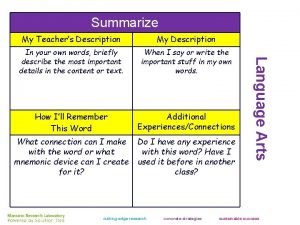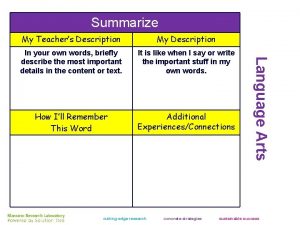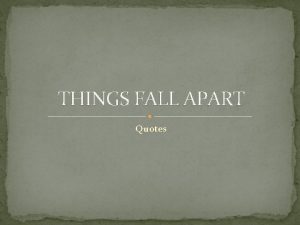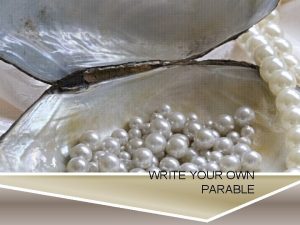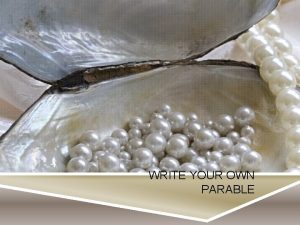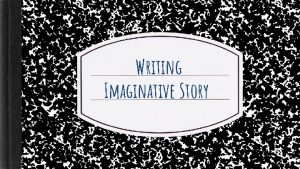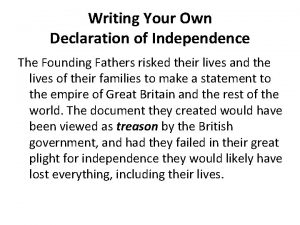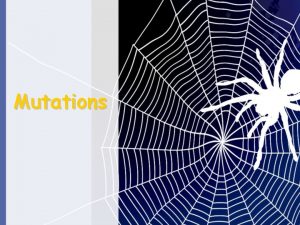Write a description in your own words you















- Slides: 15

Write a description in your own words (you may use a book if needed) : • Communism- • Socialism • Nativism • Red Scare-

Communism and Socialism • In the late 1800 s and early 1900 s, a new political ideology called communism grew out of the more moderate socialism. • Communism was based on a single-party government ruled by a dictator. Under communism, there is no private ownership; all property is owned by the state.

Red Scare • In 1919, after communist revolutionaries known as Bolsheviks overthrew the czar in Russia, established the Soviet Union, and called for a worldwide revolution to destroy capitalism, people in the United States began to fear communists. • This fear of international communism was called the Red Scare because red was the color of the communist flag. This fear led to the government’s pursuit of suspected communists and socialists.

• Immigration Restrictions The Red Scare was one factor that led to new restrictions on immigration. Other factors were two ideas that grew strong in America in the 1920 s. • One of the ideas was that people born in America were superior to immigrants. The other was that America should keep its traditional culture intact. • Anti-immigrant, anti-Jewish, and anti. Catholic sentiments contributed to the popularity of a revived Ku Klux Klan, not just in the South but throughout the nation. Ultimately, this conservative reaction against immigrants resulted in the passage of legislation that set limits on the number of immigrants who could come from each country.




• Another development of the 1920 s was the emergence of the automobile as a true replacement for the horse, not just a plaything for the wealthy. • This was made possible by an industrial process called mass production. This process was popularized by Henry Ford during the manufacture of his Ford Model T. The Model T was designed to be produced in great volume on assembly lines so the cost of each car would be low enough for common people to afford. Henry Ford

Mass Production • Mass production of the automobile made cars affordable and widely available during the 1920 s. The car allowed people to move to suburbs away from the cities, increased construction of highways and bridges, and created the family vacation, but its most powerful impact was on the relationship between young people and their parents. For the first time, young people could easily get away from their parents and experience a level of independence never before available. • This provided the young people of the 1920 s with different experiences than their parents had known and created a generation gap between them. When you think of the social changes of the 1920 s, remember the impact of the car on young people as an example of the clash between the forces of conservatism and the forces for change that exemplified the time period.

Popular Culture • During the 1920 s, popular entertainment such as radio and the movies attracted millions of loyal fans and helped create the first media stars. Conservatives often disapproved of what they viewed as the immoral influence of these forms of entertainment but were unable to reduce their popularity.

1920 s Culture

• Jazz The Great Migration significantly increased the African American populations in cities in the Northeast and the Midwest. Crowded into segregated neighborhoods near city centers, African Americans and African American culture gained the acceptance of mainstream America. • African American writers and artists began to receive the attention of major publishing houses and critics, but it was the music emerging from these neighborhoods that was the most appreciated. Jazz combined themes and note patterns developed by enslaved African Americans with the syncopated rhythms worked out by musicians in New Orleans and elsewhere in the South. It was an original American art form and became very popular in the 1920 s

• Harlem Renaissance During the 1920 s, a wave of creativity washed over Harlem that celebrated African American culture through words and song. This is known as the Harlem Renaissance. • The movement’s best-known poet was Langston Hughes, who wrote about the lives of working-class African Americans and sometimes set his words to the tempo of jazz or blues. Trumpet player Louis Armstrong, sometimes called “Satchmo, ” became known while playing with the Creole Jazz Band later became one of the biggest stars of jazz music because of his sense of rhythm and his improvisational skills.

• Tin Pan Alley While the Harlem Renaissance was occurring, another musical movement, Tin Pan Alley, was also on the rise in New York City. The name “Tin Pan Alley” is deceiving because it does not only refer to an actual place in Manhattan but also names the group of music writers and publishers who worked there. • One of the most famous was Irving Berlin, who wrote hundreds of songs during his career, including “God Bless America” and “White Christmas. ”

• Students will choose between Louis Armstrong, Langston Hughes and Irving Berlin. They will create a mock Facebook profile sheet that will detail their style, music, beliefs, culture of Harlem, life in the 1920 s etc. •
 What type of sae is when you own your own business
What type of sae is when you own your own business Description in your own words
Description in your own words Description in your own words
Description in your own words In your notebook define the following terms
In your notebook define the following terms Mosquito and the ear things fall apart page number
Mosquito and the ear things fall apart page number My own parable
My own parable How to make parable
How to make parable Sound device alliteration
Sound device alliteration Write your own riddle
Write your own riddle Spatial ordee
Spatial ordee How to write an imaginative story
How to write an imaginative story Site:slidetodoc.com
Site:slidetodoc.com Making new words your own
Making new words your own How to answer ruae questions nat 5
How to answer ruae questions nat 5 Who is the first person to arrive at juliet's tomb?
Who is the first person to arrive at juliet's tomb? Put this in your own words
Put this in your own words

